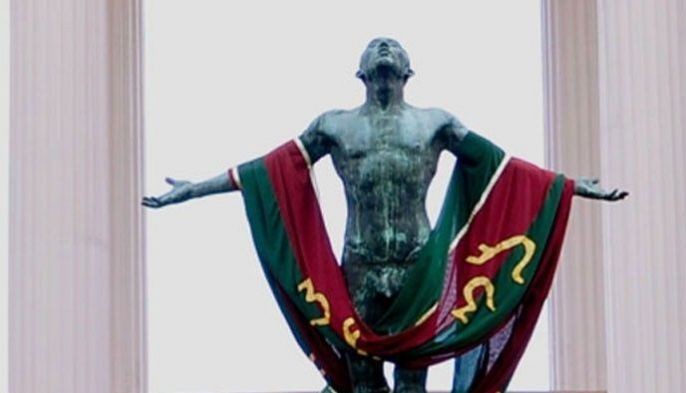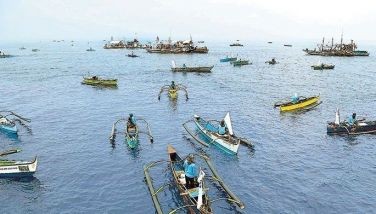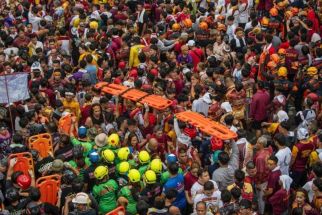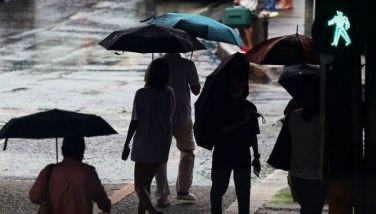Devotees pray for good health, peace in Nazarene procession
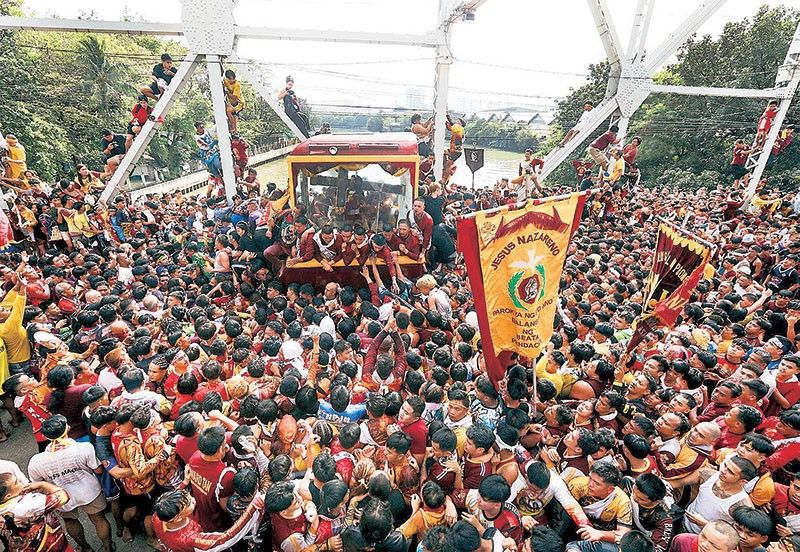
MANILA, Philippines — Hundreds of thousands of Catholic pilgrims swarmed the streets of Manila in search of a miracle yesterday, straining to reach a centuries-old statue of Jesus Christ in an annual display of religious fervor.
Some said they prayed for good health for their families, an end to tensions in the South China Sea and for incoming US president Donald Trump to be kinder to Filipino immigrants.
The procession marks the feast of Jesus Nazareno and is a major annual Catholic event in Asia. The image was previously called the Black Nazarene, but Catholic Church officials appealed for a change, saying the former name was not founded in history and evoked a racial slur.
Following the six-kilometer route, the procession to the Quiapo Church, which started before dawn after an open-air mass, was expected to swell to more than two million participants from across the heavily Catholic country, Church officials said.
Last year, at least two million devotees joined the 15-hour procession, with some estimates of the crowd as high as over six million.
Fr. Robert Arellano, spokesman for Nazareno 2025, said the procession might take longer this year as it encountered delays along the way. He urged devotees to avoid climbing onto the carriage, emphasizing that the action hinders the procession’s progress.
Barefoot men and women in maroon shirts – the color of the robe that covers the black, wooden Jesus the Nazarene statue – scrambled to grab the rope used to draw the life-sized religious icon, believing it would bring good health.
“I prayed that my mother be healed from her heart attack,” Dong Lapira, 54, told AFP of a previous procession where he had been bruised and jostled in his attempt to join those pulling the rope.
He vowed to try again yesterday – this time to see his wife healed of gallstones.
“The Nazarene is very sacred. It has granted many prayers,” Lapira said.
Some faithful frantically threw white towels to worshippers tasked with guarding the float, hoping God’s blessings might rub off on the cloths used to clean the statue’s glass case.
One of the volunteer guards, Alvin Olicia, 38, said he was unaffected by the “extreme heat or rain” he had confronted at past processions. “I don’t feel it at all. I like my task, because through catching other’s handkerchiefs, I feel like I am connecting them to their faith and to the Nazarene.”
Ester Espiritu, 76, who travelled 35 kilometers from her home in Cavite, said just catching a glimpse of it would be enough.
“Even if I’m struggling to come here because of my age... I feel happy and well whenever I see the Nazarene,” said Espiritu, who added she was praying for relief from a lingering shoulder injury.
Gaspar Espinocilla, a devotee of the Nazareno for the last 20 years, said he is praying for his family, including his sister who has ovarian cancer, and an end to tensions in the West Philippines Sea, where China has been harassing Filipino fishermen and coast guard vessels.
“I hope China will ease up on us, they cannot seize everything as theirs. It is ours, not theirs,” Espinocilla said.
Renato Reyes, a garbage scavenger who has been a Nazareno devotee for more than 30 years, said he prays for a better life for his family, for the Philippines to be free from calamities, for wars overseas to end and for Filipinos who may be affected by Trump’s planned mass deportation of illegal immigrants.
“I hope they (US officials) will not implement that because our countrymen are there just to earn a living for their families,” Reyes added.
For 40-year-old Ronnie Beltran of Quezon City, Jesus Nazareno granted his wish of having a child – a wish he has been praying for since 2010.
Beltran brought his three-month-old son Prince Aaron and his wife at the “pahalik” or public veneration of the 419-year-old statue of the Jesus Nazareno at the Quirino Grandstand at 7 p.m. on Jan. 8.
While they were in line, they heard the Misa Mayor – the first of the 33 hourly Fiesta Masses symbolizing each year of Jesus’ life – presided by Manila Archbishop Jose Cardinal Advincula at midnight of Jan. 9.
According to Beltran, having a child was a wish he brought before Jesus Nazareno when he joined the Traslacion last year, when it was restored after a three-year hiatus due to limits on mass gatherings due to the COVID-19 pandemic.
Solidarity, camaraderie
President Marcos said the annual celebration of the icon was a “testament to our people’s solidarity and camaraderie” as he called on Filipinos to face their trials with faith and to show kindness to the needy, highlighting their roles as “hope bearers, peacemakers and builders of society.”
In his message for this year’s Traslacion, Marcos described the feast as a “historic tradition founded in great devotion” that reminds Filipinos of the strength that allows them to find harmony in their faith as a people.
“This colossal gathering of Filipinos in the streets of Manila is a testament to our people’s solidarity and camaraderie. Let us remember that we are all called to hurdle the challenges that test our resolve with faith and grace as well as to reach out to those around us who need our kindness and empathy,” the President said.
Vice President Sara Duterte urged the public, especially the devotees of the Black Nazarene to “show humility, kindness and mercy” to everyone in need, even to those who persecute them.
In her message, Duterte said the event is a constant reminder that God is with His people especially in times of challenges.
“The Black Nazarene is a manifestation that we will never face the challenges that come our way alone – because God is constantly guiding us, walking with us and carrying the cross for us on the way to salvation,” Duterte said.
Police said about 14,500 security personnel had been deployed along the procession’s six-kilometer route as a precaution.
Mobile phone signals were blocked to prevent the remote detonation of explosive devices during the parade, which is expected to last up to 18 hours, police said.
While authorities have banned devotees from climbing on the carriage, some still clambered over other attendees, risking life and limb to be near the statue.
Emergency response teams were stationed along streets, with the Philippine Red Cross saying it assisted 526 devotees – mainly for dizziness, nausea and weakness –with at least 15 people taken to hospitals and PRC’s medical facility as of 4 p.m.
The Metropolitan Manila Development Authority reported treating another 120 devotees after getting injured or from suffering other health issues while joining the jampacked procession.
Thousands of police and plainclothes officers were deployed, along with drone surveillance and commandos positioned on rooftops along the procession route.
The statue of Jesus carrying the cross was brought to the Philippines from Mexico on a galleon in 1606 by Spanish missionaries. The ship that carried it caught fire, but the charred statue survived, according to some accounts.
Church historians, however, said the statue’s color owes to the fact that it was carved out of mesquite wood, which darkens as it ages.
Many devotees believe the statue’s endurance, from fires and earthquakes through the centuries and intense bombings during World War II, is a testament to its miraculous powers.
Fr. Arellano said the devotees of the Nazareno are showing signs of maturity as seen by their peaceful and orderly conduct during the start of the Traslacion at 4:41 a.m. from the Quirino Grandstand in Manila.
“There was no report of any commotion or chaos or anything that disrupted the (midnight) mass, vigil because this is the most important religious activity here,” Arellano said.
“If you will notice when the cover of the andas (carriage) was removed, the people were quiet and everybody cooperated. We are just hoping that this would be the situation until it (andas) reaches Quiapo Church,” he added.
The Church official believed that the orderly behavior of the devotees could be a sign of maturity.
“This is our prayer that every year there will be a change. When it comes to the maturity of the devotees, it is a good sign that their faith is deepening. They now see what is important and what is not (important),” Arellano said.
One example of the devotees showing maturity, he added, “was when the andas was uncovered, the people were no longer rowdy. Not like during the pre-pandemic when there was shouting, very aggressive. Now, it is quiet and the andas traveled fast.”
Fr. Rufino Sescon Jr., Quiapo Church rector, said this is the first time that the Feast Day of Jesus Nazareno would be celebrated on a national scale.
He told the crowd at Quirino Grandstand that, “For the first time, we are now celebrating Jan. 9 as the feast day of Quiapo, feast day of Manila because today is the feast day of the entire country, the feast day of every Filipino, wherever they maybe in the world.”
“In my almost three years here at Quiapo Church, it cannot be denied that the Quiapo Church is a national parish because millions of people come here to pray for the mercy and miracle of Jesus Nazareno… the Shrine of Jesus Nazareno is the house of every Filipino,” Sescon added.
In the midnight mass, Cardinal Advincula urged devotees to remember two things – to hope in Jesus and to follow Jesus.
“Every time the people shout Viva! to Jesus Nazareno, we are saying that the Señor is alive. He is alive in our hearts,” Advincula said. – Alexis Romero, Elizabeth Marcelo, Ghio Ong, Rhodina Villanueva, Mark Ernest Villeza AFP
- Latest
- Trending




















